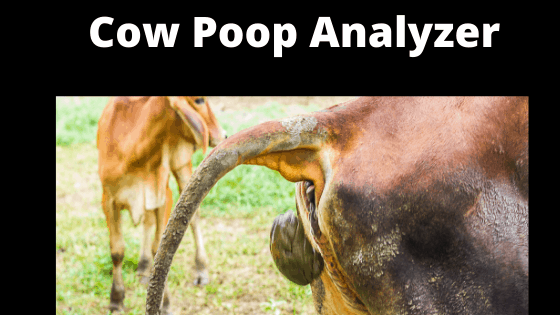Cattle Poop Analysis
Cow Poop Analyzer – You can scrape, wipe or move it from the barn every day. But what you might not do is use it to evaluate your cow rumen health.
Cow poop evaluation can provide a huge clue when trying to evaluate conditions inside the rumen and intestine of the dairy cow.
Poop evaluation is not a precise science; it cannot provide definitive answers to nutritional questions.
Manure evaluation may be a useful diagnostic tool for some health-related issues, but it only gives the nutritionist or farm manager a hint of what might be happening during the digestive process.
Mature cattle provide ample opportunity to observe manure, as it excretes manures approximately once every 1.5 to 2 hours and releases a total of 29 or more kilograms per day. – 65 lbs / Day, 12 Tons / Year. up to 15 times a day.
The amount of manure produced can vary depending on feed and water consumption and can be significantly reduced by unusual disorders of the digestive tract.
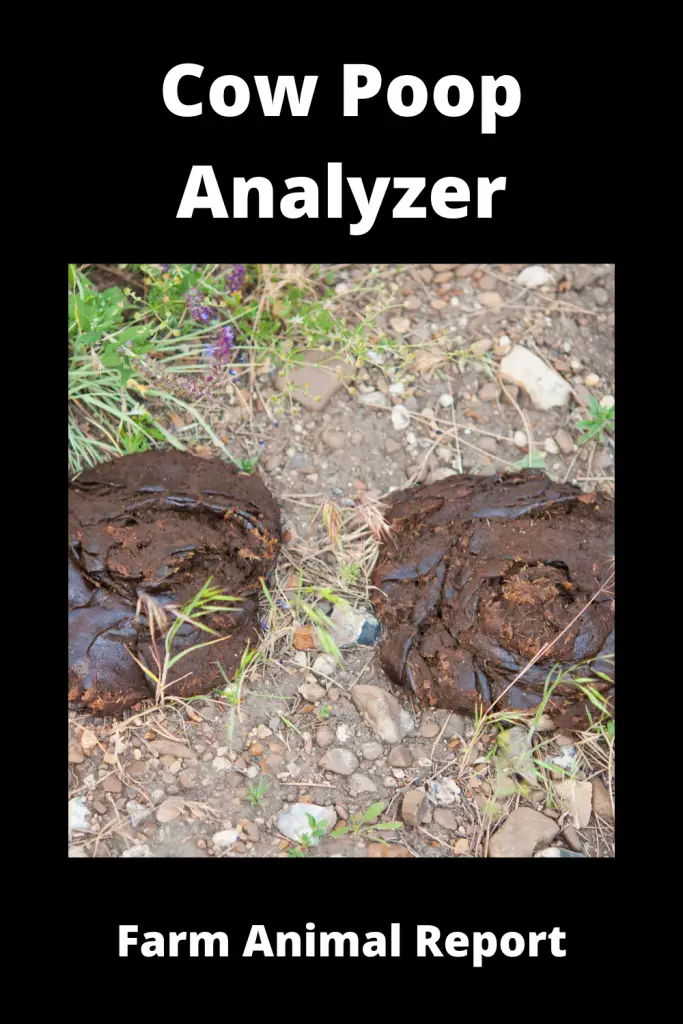
Normal digestion process
Cows may spend 35 to 40 percent of each day ruminating. The amount of time cow spend depends on the diet.
Little ruminating occurs when cows eat grain or finely ground rations. But when eating long hay, cows may ruminate for several hours.
Adult cattle spend little time chewing while eating. Thus, during rest periods, the cows regurgitate soft cud to re-chew and break them into smaller pieces.
They also replenish saliva and swallow it. This process makes it easy for microbes to digest the food.
Normally a majority of the feed consumed by the cow is digested in the rumen, and a majority of the nutrient absorption occurs in the rumen or small intestine.
The digestion process starts from the rumen. Ruminant stomachs have four compartments: the rumen, the reticulum, the omasum, and the abomasum.
Rumen microbes ferment feed and produce volatile fatty acids, which is the cow’s main energy source.
If the feed is not properly fermented in the rumen some undigested nutrients may reach the small intestine.
In normal digestion procedure these nutrients may be digested and absorbed in small intestine.
But if the amount of digestive material is excessive and passage rate is fast, nutrients may escape both digestion and absorption in the small intestine.
The last site of digestion and absorption is large intestine.
If cows consume feed that lacks in fiber or too high in non-structural carbohydrates (NSC), hindgut fermentation may be increased, resulting in negative effects on cow health and production.
In hindgut, the feed particles or nutrients that are not digested and absorbed are excreted in feces and urine.
See Our Guide – Ways to Make Money Cattle Farming
The general condition of poop
Cow poop illustrates the condition of the rumen and intestine of the cow. If manure is from a healthy, high-producing cow it should look like a pile of shaving cream. Too much DIP will increase manure looseness.
If a group of cows suffers from acidosis, some compost is harsh, some are right, and some will be loose and some are shiny and contain small bubbles.
Cattle manure is basically made up of digested grass and grain. Cow dung is high in organic materials and rich in nutrients.
Grains will appear in the compost if there is a weakness in the rumen mats due to a lack of effective fibers or if the rumen microbes are unable to digest the grains quickly enough.
Main points to be seen in manure are given below
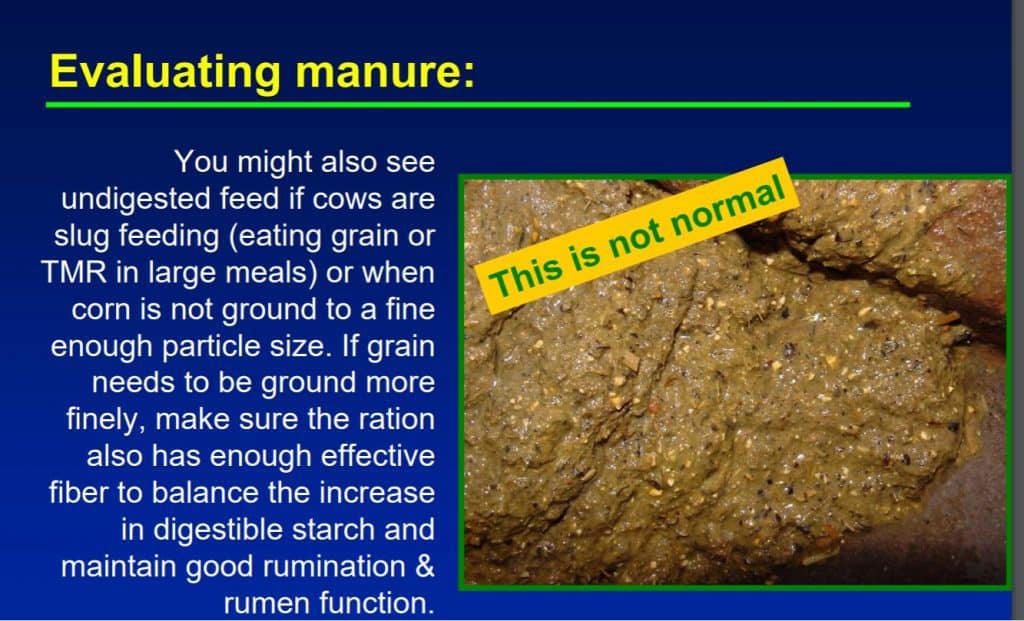
The Three C’s of Manure Observations
Color
Your cow fecal color is affected by the type of feeding, the concentration of bile, the rate of passage of feeding and digestion.
Cow manure is usually dark green when cows graze on fresh feed and darken to brown olives if the cow receives a serving of straw.
When your cow consumes a portion that contains large amounts of cereal, a typical TMR, for example, the stool is usually a color of yellow-olive.
This color is caused by a mixture of grains and fodder and will vary according to the quantity and processing of the grains.
If your cow experiences diarrhea, the stool may change to gray. Cow subjected to medical treatment may excrete abnormal colored stools as a result of the medication given.
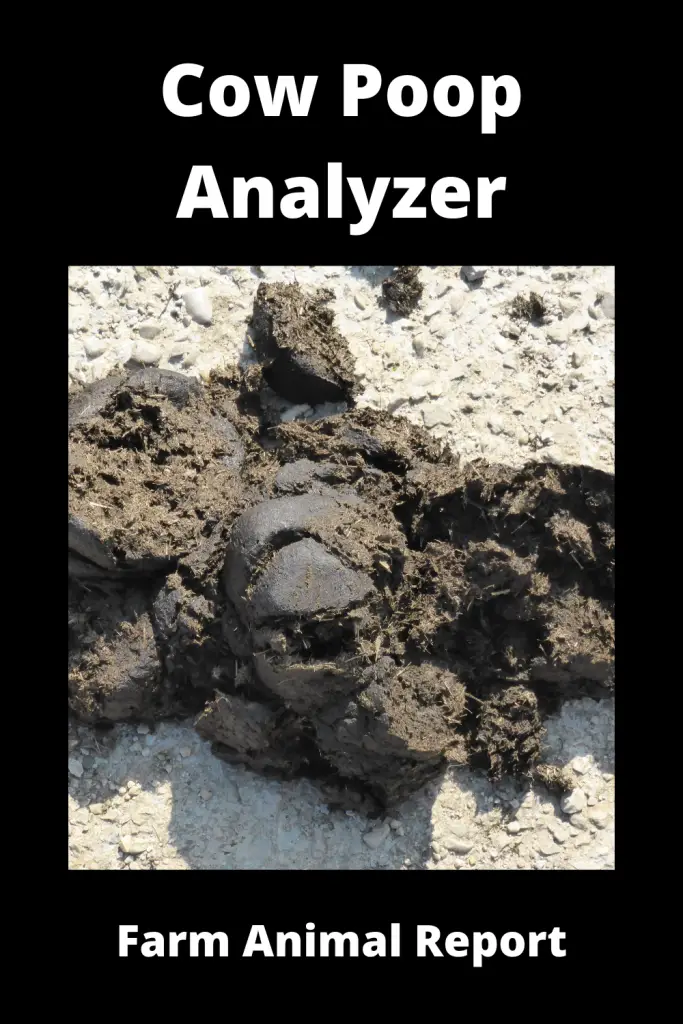
Dark or bloody manure may indicate hemorrhaging in the GI tract from watery dysentery, mycotoxins, or coccidiosis.
Light-green or yellowish manure combined with watery diarrhea can result from bacterial infections such as salmonella.
Consistency
The consistency of the stool is largely dependent on the water content, feed moisture content and the time feed remains inside the cow.
Regular fecal matter has a consistency similar to porridge and forms a dome-shaped pile 1 to 2 inches high.
Diarrhea may be caused by poisoning, infection, or parasites, but it may also be caused by the Hindgut fermentation of carbohydrates and increased acid production.
Loose stools may also be caused by excessive protein intake or high levels of degradable protein.
This is most likely due to increased water consumption in an attempt to excrete excess nitrogen through the urine.
Additionally, dung may be loose during periods of heat stress. Restricted water or protein intake often leads to firmer stools.
Severe dehydration creates solid balls of manure. Cows with abomasum displaced from the left side often excrete stools with a fungal appearance.
Content
In most of the cases fecal samples should indicate uniform digestion and use of most of the feed and nutrients provided to the animal.
If you notice large proportions of undigested grains or long feed particles (pieces greater than 0.5 inches) then this may be an indication of poor rumen fermentation and possibly extensive hindgut or large intestine fermentation.
Large intestine fermentation is less valuable to the cow than rumen fermentation.
This is due to the fact that little absorption of digested nutrients can occur in the large intestine. Therefore a little nutritional value is obtained for the cow.
Large particles of undigested feed or grain may indicate that the cows do ruminate properly or that the rumen passage rate is increased.
This may be due to insufficient intake of fibers that are effective in stimulating and maintaining a normal rumen pH.
Observing a large number of undigested grain particles may indicate grain congestion or improper processing of the grain.
The nutrients from these large particles are not available for animals or microbes of rumen.
A pale white color on the surface of dried manure indicates undigested starch is present and the amount of white color depends on the amount of starch present.
Excessive amount of mucus indicates chronic inflammation or injury to intestinal tissues.
The damage to the large intestine is possibly caused by extensive hindgut fermentation and low pH.
Mucin is produced by cells that line the intestine in an attempt to heal the affected area.
Feces that appear foamy or bubbly may indicate lactic acidosis or excess fermentation of Hindgut, resulting in gas production.
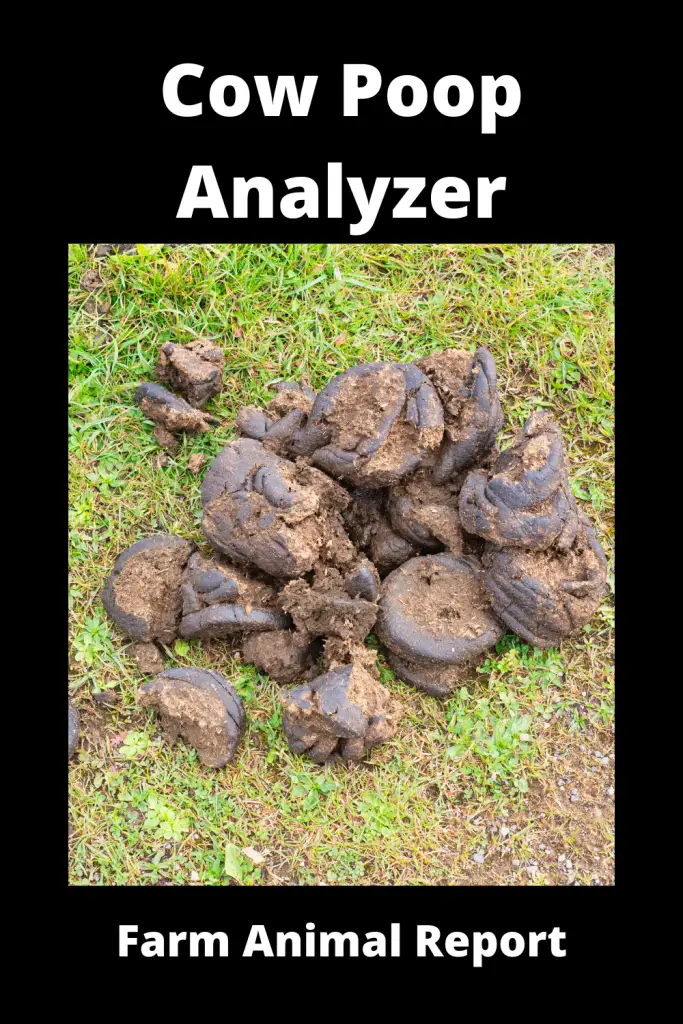
Physical Analysis
To assess the size of the fecal sample particle, walk through the barn and observe the droppings of the whole barn.
Look at the recently passed feces. Check the consistency of manure piles within animal groups.
There is naturally some manure variation, and the distinctive diurnal difference in excretion is natural for lactating dairy cows.
This diurnal variation is due to the variation in food intake throughout the day, partly due to the management and daily movement of animals.
The significant difference within a group of cows during a similar time period of the day is a clear indication of the ration quotas being sorted by cows or some other health or administrative problem that does not affect the cows on an equal footing.
How to prepare a poop sample of the cow for analysis?
This type of variance indicates that ration management may need to be adjusted.
- Collect at least five manure samples that appear to be representative of the group of animals.
- Mix the collected samples.
- Place a pint-sized sample on a. 05-.08- inch mesh sieve or in a strainer.
- Using a hose, wash a gentle, steady stream of water over the sieve.
- Passing across the sample continuously until the water running from the bottom of the sieve is clear.
- Then gently use running water to roll or float the particles to one corner of the sieve and remove all material from the sieve.
Place the washed sample on a flat dark surface and examine it for the following things:
Long fiber particles
It is predictable that some long forage particles will appear, but if they are more than 0.5 inches there may be cause for concern.
So you should look for large, coarse fiber particles that exceed 0.5 inches in length.
It means manure that contains coarse fiber particles greater than 0.5 inches in length could mean your cows are not getting enough forage, or physically effective fiber in the diet.
It will happen when the rumen cannot maintain an adequate fiber mat.
Therefore, fiber particles escape the rumen too quickly and do not have sufficient time to be digested or fermented.
Feed sorting is a common reason why cows may not be getting enough effective fiber.
Poor digestion may be due to the composition of the fiber component in the diet (low-quality feed) or to the animal’s ability to digest the feed.
Grain particles
The small intestine is able to digest starch, allowing the cow to use these nutrients. However, the amount of starch digested is limited by the rate at which digesta passes through the small intestine.
Some feed particles will be observed in the manure of almost all highly productive cows.
You should look for noticeable amounts of ground grain or undigested feed in the manure. Grain particles are smaller than 0.25 inches.
A small amount of grain in manure is not a problem. However, the presence of noticeable amounts of ground grain or undigested feed such as citrus pulp, beet pulp or cottonseed with the lint still intact, indicates the feed has passed through the rumen too quickly.
Therefore, it was not sufficiently digested or fermented. Problems with silage harvest methods, slug feeding of grain, and inadequate grinding of dry grain could be the culprit.
This is predictable because high producers have a high rate of feed intake and a fast rate of passage of feed from the rumen.
These cows require a higher energy density for rations, and therefore high-grain diet is used in an attempt to meet their energy needs.
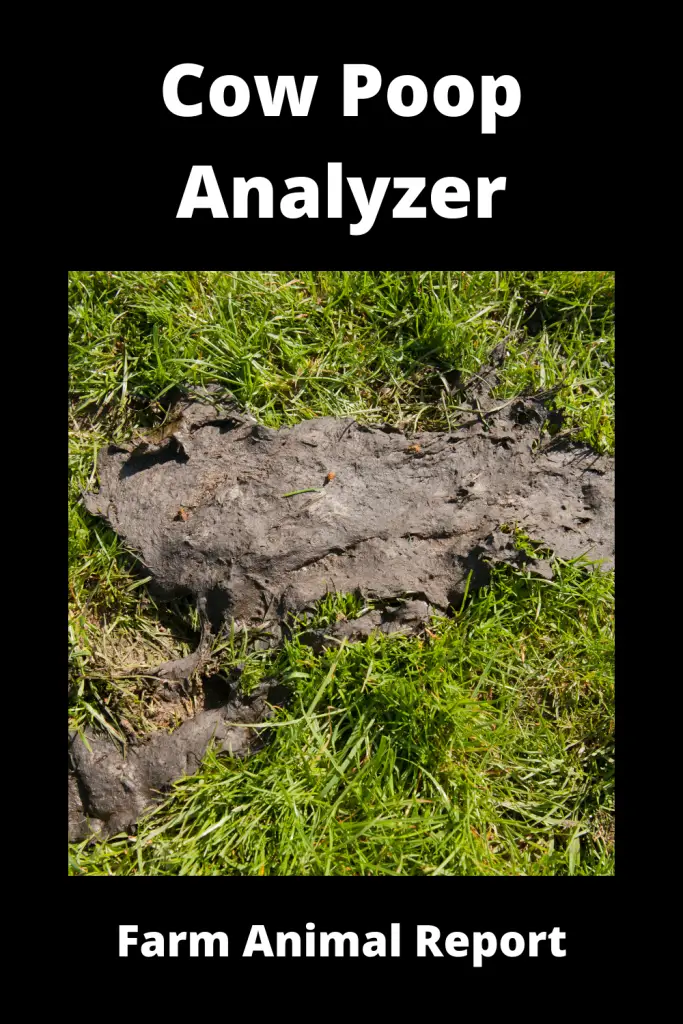
This often creates a situation in which starch is fed with more than the amount that can be used for rumen.
The extra grain feeding should be reduced to a minimum and should be constantly monitored by the herd nutritionist.
The starch in the corn kernels can be partially or completely digested, while the kernel remains intact.
Corn silage often produces such kernels with the starch digested from the outer shell, so inspect kernels carefully, especially when corn silage is fed.
Mucin casts
Cow manure may contain tubes of mucous or “mucin casts”. Use the “toe test” to find mucin casts.
To do so, slide the toe of your boot across a manure pile. If something that resembles a sausage casing moves after your boot has passed, it’s probably a mucin cast.
When washed, mucin casts may be long or shredded in appearance. They also tend to take on the shape of the large intestine, although they are not part of the lining of the intestine.
Mucin casts result from damage to the large intestine. This can happen when grain or other fermentable carbohydrates escape rumen fermentation and end up in the large intestine.
Once there, these feeds ferment, resulting in acid and gas production. The acid produced as a result of fermentation can damage the large intestine.
Mucin casts are the cow’s way of saying her large intestine has been injured. The presence of mucin casts often means rumen fermentation is not working optimally.
Diarrhea
Diarrhea caused by a non-disease condition occurs when the feed escapes from the rumen and ferment in the large intestine.
Fermentation produces acid and gas – two culprits responsible for producing mucin casts and foamy manure.
Acid production irritates the intestine and causes diarrhea. These signs indicate insufficient rumen fermentation.
A washed diarrhea sample may reveal coarse particles or undigested feed, as in foam compost.
However, consuming excess protein and some minerals can cause loose compost. It can be occur due to spoiled or moldy feed.
Cow also gets infected by diarrhea due to attack of different types of virus, bacteria, fungus, germs like protozoa, various types of worm etc.
The cattle get infected by diarrhea by eating rotted and polluted hay, leaves, straw etc. from the field while grazing.
They also caught by this disease by consuming water hyacinth
Foamy Manure
Manure that is foamy or bubbly results from the fermentation of grain or other fermentable carbohydrates in the large intestine.
However, gas production is the culprit in this case. The gas produced during intestinal fermentation appears as bubbles or foam in the manure.
Again, this indicates rumen fermentation is not working as it should, and undigested feed passes through to the large intestine.
Foamy manure also could mean grain is passing through the rumen too quickly.
Cow Poop Analyzer App
With the “Cow Poop Analyzer” app, you take a picture of a poop pile, and then compare your picture to file photos.
Each file photo comes with an estimate for the crude protein and digestibility you can expect from your forage based on the quality of the manure.
Even better, you can add a title and pasture name to the automatically dated record. Then you’ll have a history of forage quality in your pastures over time.
Lab tests for Cow poop analysis
Sampling manure for analysis is an essential and valuable tool for determining the parasite available in manure.
Your vet or lab can determine the type of parasite inside the cow because parasite eggs are passed in the fecal material.
Different lab tests are available for analysis of cow manure such as:
- Flotation methods for nematode and fluke eggs and coccidia oocysts
- Sedimentation technique for fluke eggs
- Baermann’s technique for lungworm larvae identification Lungworm and larval culture.
- Oocyst sporulation and identification
How to collect the poop sample for lab test?
There are several approaches that can be used to collect feces. It is important that the same approach is used each time samples are collected.
Procedure 1 – Sampling cows in free-stall systems by consultant
In most cases, as you walk into the free-stall barn, cows will stand up and defecate. Collect the appropriate number of samples and try to keep bedding contamination to a minimum.
For dry cows and heifers, animals should be restrained to keep both people and animals safe. Rectum fecal samples may need to be taken.
Check that there are no bulls in the free stall
Procedure 2 – Sampling cows in a tie-stall barn by consultant
In tie-stall barns, it may be necessary to take fecal samples from the rectum in order to get the distribution of days in milk.
Procedure 3 – Sampling cows in free-stall systems by producer
If the herd is on a routine herd check program and the producer is agreeable to taking fecal samples while animals are restrained, the consultant can explain the basic protocol for taking fecal samples.
It will be extremely important that samples be refrigerated or frozen if they cannot be mailed out immediately.
If heifers and cows are on a breeding synchronization program, fecal samples could also be taken at this time.
It is recommended that the consultant fill out the paperwork and take care of getting samples mailed out unless the producer is willing to do the extra work
Final Thoughts
The general herd health and nutrition examination includes collecting information from all areas of the farm, and fecal assessment is one of the valuable sources of information.
In addition to thoroughly examining nutritional and management practices, fecal assessment can help clarify the problems associated with the use of nutrients for whole animals related to animal health.
Combining fecal assessment information with cow health, performance and behavior can be an important link to understanding the ration-animal interaction.
Cow poop assessment is done at your own pace, but it is one of the tools that a dietitian can use to determine the best comprehensive nutritional program for a dairy farm.


